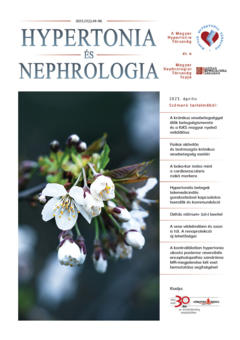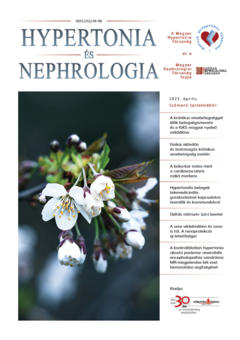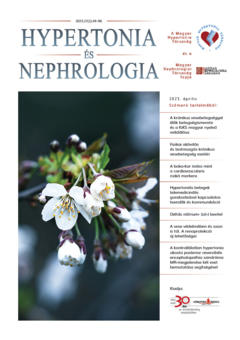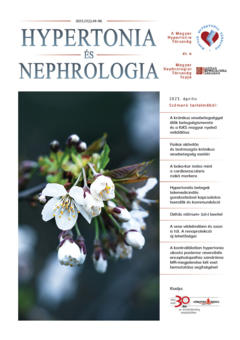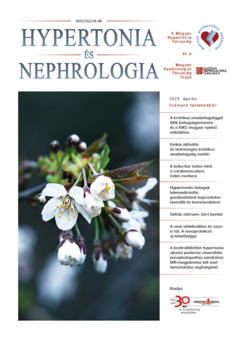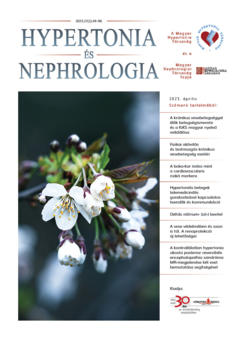The eLitMed.hu medical portal uses computer cookies for convenient operation. Detailed information can be found in the Cookie-policy.
Hypertension and nephrology - 2023;27(02)
Content
[Disease Knowledge of Chronic Kidney Disease Patients and the Hungarian validation of Kidney Disease Knowledge Survey]
[In Hungary, approximately every tenth person is estimated to suffer from chronic kidney disease (CKD). Exact knowledge of CKD is essential regarding the coping strategies and self-management of patients, futhermore to prevent the progression of the disease. The 28-item Kidney Disease Knowledge Survey (KiKS) is a knowledge test, developed by Wright et al. in 2011, to measure the knowledge of CKD. In Hungarian, there is no available validated knowledge test of CKD, therefore the objective of our study is to validate the Hungarian version of KiKS as well as to examine its association with sociodemographic and illness-related variables. In our cross-sectional survey study, 149 predialised patients (64 men, mean age: 63.83) diagnosed with CKD (stadium 1-5) participated. Beside using Exploratory Factor Analysis, we tested the survey’s convergent and divergent validity. According to our results, the homogeneity of the test is 0.641, which indicates an acceptable reliability. The mean of the correct answer rate is 56.64%, which shows a somewhat lower disease knowledge in comparison with the international results. Problem areas for our patients included identifying the avoidable medications, the relation between proteinuria and damaged kidney function, the symptoms of CKD, and interpreting GFR. ]
[Physical activity and exercise in chronic kidney disease. Walk, run, dance, play. Move what you can!]
[The link between regular physical activity and reduced cardiovascular risk in the general population is clear and has been proven by numerous studies. However, the studies available to date on this topic in patients with kidney disease have shown conflicting results, although physical activity in this patient group also has beneficial effects on blood pressure reduction, quality of life, muscle strength, physical fitness and performance. It is important to emphasise that even a minimal increase in physical activity has a positive effect, but international quidelines recommend at least 150 minutes of moderate-intensity aerobic exercise (e.g. cycling or walking) per week for both haemodialysis and non-dialysis kidney patients. For dialysis patients, in addition to exercise on dialysis-free days, intradialytic exercise may also play an important role. Healthcare staff involved in the care of chronic kidney failure patients plays a crucial role in increasing physical activity among kidney patients by appropriate patient education.]
[The ankle-brachial index as a marker of cardiovascular risk]
[Determination of asymptomatic organ damage is an important part of cardiovascular risk estimation. Peripheral arterial disease (PAD) can be diagnosed in early, asymptomatic stage with the measurement of the ankle-brachial index (ABI). Low (≤0.9) ABI is accepted as a marker of high cardiovascular risk. In 2007, the Hungarian Society of Hypertension launched a nationwide screening program with the participation of 55 centres, the aim of which was to detect asymptomatic vascular disease by measuring the ankle-brachial index. The first period of the study was conducted from April 2007 to September 2008 in 55 hypertension outpatient clinics in Hungary and the prospective phase was ended in April 2014. In all patients ABI was measured and cardiovascular outcomes were collected in a 5 years follow-up period. In the ÉRV Program 21,892 hypertensive patients (50-75 years of age) were enrolled, the prevalence of PAD (ABI ≤0.9) was 14.4%. In 9.4% of the subjects high ABI (>1.3) was measured. In this hypertensive cohort, the majority (58%) of the patients had low or mildly elevated SCORE risk, while only 13% of the patients had more than 10% risk. The mortality results demonstrated, that irrespectively of the actual SCORE category, having an ABI ≤0.9 substantially increased the risk of mortality in all patient groups.]
[Telemedicine care and communication duties for hypertensive patients]
[Hypertension is one of the most common chronic diseases with a significant health burden for society. In its management, the last decade has seen a greater emphasis on simplification and standardization of treatment methods rather than the emergence of new drugs. Yet the control of the disease is not improving as much as expected. The answer to this may be to change the way the disease is managed. One of the milestones is the spread of home blood pressure monitoring, which is expected to lead to lower blood pressure values, better adherence and greater health awareness. However, an analysis of the results shows that more complex interventions are more likely to achieve these goals. One of the keys to chronic disease care is effective communication. One direction of development is through mobile and wearable devices that register data, transmit them to the health system and feed them back to patients. Motivational, educational and complex lifestyle change apps can help to improve disease control. Yet the observed results are not overwhelmingly good. Another development is remote communication with health professionals, telemedicine. This is based on home blood pressure monitoring but includes data transfer, therapy confirmation or modification, education, counseling and motivation.]
[Dietary sodium (salt) intake: facts and global call to action]
[2022 elején 70 nemzeti és nemzetközi egészségügyi és tudományos szervezet támogatta a „2022 World Hypertension League, Resolve to Save Lives and the International Society of Hypertension dietary sodium (salt) global call to action” (1) című dokumentumot, amely a címben szereplő három szervezet konszenzusaként lett megfogalmazva. Ez a tényeket felsoroló és globális cselekvésre felhívó közlemény a világszerte legjelentősebb egészségügyi és tudományos szereplők állásfoglalásaként értelmezhető. Ez a rövid összefoglaló az eredeti közlemény kivonataként kitér: a) az emelkedett diétás nátriumbevitel okozta betegségtöbblet jelentőségére; b) a diétás nátriumbevitel csökkentését támogató evidenciákra; c) javaslatokra a diétás nátriumbevitel csökkentésére; d) a jelenlegi nátriumbevitel mértékére; e) a diétás nátriumbevitel csökkentésének költséghatékonyságára; f) az ellentmondásos irodalmi források néhány fontosabb okára; g) a diétás nátriumbevitel csökkentésének lehetőségeire; h) azoknak az evidenciákat gyakran felülvizsgáló weboldalaknak a forrására, amelyek az emelkedett diétás nátriumbevitel egészségkárosító hatásaival és a nátriumbevitel csökkentésének módszereivel foglalkoznak. A felhívás ösztönzi az egészségügyi dolgozókat, a kutatókat és az egészségügyi szervezeteket, hogy aktívabban támogassák, hogy a diétás nátriumbevitel csökkentése globális prioritást képezzen és az összes nemzet tűzze ki célul a diétás nátriumbevitel javasolt szintig való csökkentését.]
[For kidney protection and beyond. New possibilities of renoprotection]
[As a result of intensive basic research and clinical trials of the last decade, drugs with a new mechanism of action of renoprotection have entered clinical practice. Following the drugs that act by inhibiting the renin-angiotensin system, which are already considered the "gold standard", the new drugs originally designed and introduced for the treatment of diabetes mellitus have expanded our therapeutic armamentarium, such as glucagon-like peptide-1 receptor agonists (GLP-1RA), with evidence of reducing macroalbuminuria and serum creatinine in diabetic nephropathy and sodium glucose cotransporter-2 (SGLT-2) inhibitors, showing evidence of nephroprotection in patients with diabetic nephropathy as well as in CKD with non-diabetic etiology. Well-designed clinical trials have also confirmed the cardiovascular protective effect of these drugs, and in this context, a number of proven and potential mechanisms have been described that may play a role in the effects described above. The observation that the nephroprotection originally proven in diabetes is also valid for SGLT-2 inhibitors in non-diabetic chronic kidney patients is particularly promising, providing a new therapeutic tool to slow down the progression of chronic kidney disease. In the future, the mechanism of action of these drugs needs to be further clarified. The final goal is to verify their effectiveness in large population based studies including patients from the "everyday life".]
[ MR appearance of posterior reversible encephalopathy syndrome due to uncontrolled hypertension with the help of two case reports]
[N. M. J. 60 éves nőbeteget heves fejfájás, forgó jellegű szédülés és több alkalommal jelentkező hányás, valamint ébredéskor jelentkező mindkét szemét érintő látásvesztés miatt szállították be a Semmelweis Egyetem Sürgősségi Orvostani Klinikájára. Beérkezésekor mért vérnyomása 200/100 Hgmm, pulzusa 60/perc volt. Eddig nem volt ismert és kezelt hypertoniája, illetve nem volt egyéb ismert társbetegsége. Az akutan elvégzett koponya-MR-vizsgálat (1. ábra) friss vérzést, ischaemiát nem igazolt, ellenben mindkét oldalon occipitalisan foltos intenzitásfokozódás látszott, amely alapján a neurológiai konzílium posterior reverzibilis encephalopathia szindrómát (PRES) véleményezett.]
1.
Clinical Neuroscience
Is there any difference in mortality rates of atrial fibrillation detected before or after ischemic stroke?2.
Clinical Neuroscience
Factors influencing the level of stigma in Parkinson’s disease in western Turkey3.
Clinical Neuroscience
Neuropathic pain and mood disorders in earthquake survivors with peripheral nerve injuries4.
Journal of Nursing Theory and Practice
[Correlations of Sarcopenia, Frailty, Falls and Social Isolation – A Literature Review in the Light of Swedish Statistics]5.
Clinical Neuroscience
[Comparison of pain intensity measurements among patients with low-back pain]1.
Clinical Neuroscience Proceedings
[A Magyar Stroke Társaság XVIII. Kongresszusa és a Magyar Neuroszonológiai Társaság XV. Konferenciája. Absztraktfüzet]2.
3.
Journal of Nursing Theory and Practice
[A selection of the entries submitted to the literary contest "Honorable mission: the joys and challenges of our profession" ]4.
Journal of Nursing Theory and Practice
[End of Life and Palliative Care of Newborns in the Nursing Context]5.
Journal of Nursing Theory and Practice
[Aspects of Occupational Health Nursing for Incurable Patients ]